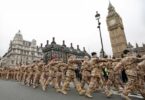Isaev Alexey
80 years ago, on January 13, 1942, the operation of German submarines in the waters of the United States, codenamed Paukenschlag, was launched. The Nazis were able to view the skyscrapers of Manhattan through binoculars – World War II came to America. American historian Michael Gannon called the events of 1942 in the Atlantic waters washing the coast of the United States, the second Pearl Harbor. In my opinion, this is a rather harsh assessment, not all of Gannon’s arguments and accusations can be accepted unconditionally, but still there are good reasons for such a formulation.
From January to August 1942, German submariners sank about 600 ships off the coast of the United States – the German crews regarded this as “the second fat times” by analogy with the beginning of World War II in Europe, when the British anti-submarine defense was still weak and the convoy escort system had not been formed. Then it was possible to sink a large number of merchant ships with minimal losses.
Operation Paukenschlag (often translated as “drum roll”) began planning soon after Adolf Hitler declared war on the United States on December 11, 1941. Strictly speaking, by that time the American armed forces were actually already involved in the struggle on the lines of sea communications in the Atlantic. Nevertheless, “Paukenschlag” was a serious and reckless step on the part of the German leadership.
At that time, German submarines were in one form or another involved in supporting the Wehrmacht’s operations in North Africa. The ideologue of the “wolf packs” Karl Dönitz, at that time still vice admiral and commander of the submarine forces of the Third Reich, considered operations in the Mediterranean Sea ineffective and dangerous. The return to the open spaces of the Atlantic made it possible to return to the actions for which the German submariners were preparing in the pre-war years. Therefore, with the greatest enthusiasm, the declaration of war on the United States was received by the German naval command.
The main obstacle to the implementation of Dönitz’s ambitious plans was the lack of combat-ready submarines. On January 1, 1942, due to losses, the diversion of part of the forces to the Arctic and the Mediterranean Sea, the Germans were able to put 64 boats into the Atlantic: 19 – IX series, 44 – VII series and one former Turkish UA. At the same time, a fifth of them – 14 boats – were under repair.
Despite the development of the technology of the submarine fleet, the huge distance between the bases of the German fleet in occupied France and New York (3 thousand nautical miles) allowed only German series IX boats to operate independently off the coast of the United States, which are in combat readiness off the coast of America at the disposal of the Kriegsmarine on December 1941, there were only six pieces. Series VII boats could operate confidently only off the coast of Canada. At the same time, the submarine commanders objected to such a use of these submarines, considering it more expedient to use them against convoys in the Atlantic. Nevertheless, Dönitz insisted on his own – it was to his pen that the Paukenschlag plan, prepared by December 17, 1941, belongs. Its main idea was to inflict maximum damage by the actions of single boats on a wide front, without trying to form “
The first three large series IX submarines entered positions in US territorial waters on January 13, 1942. Their first victim was the Panamanian tanker Norness, sunk by U-123 under the command of Lieutenant Commander Reinhard Hardegen on the night of 14 January. In the evening of the same day, U-123 approached the New York harbor, a photographer was called on the deck, but it was too dark, and the German propagandists could only fabricate pictures of the “New York lights” based on the murky footage from Hardegen’s submarine.
Ten boats of the VII series near Newfoundland and Nova Scotia achieved their first success on January 15, 1942, when a submarine under the command of the famous German submarine ace Erich Topp sank the British ship Dayrose. However, already on January 22, presumably due to a lack of fuel or having used up torpedoes, all ten boats of the VII series headed for the base. They were already operating at the limit of their range, which was not facilitated by bad weather conditions.
Results of the operation
Was the operation of the German submariners off the coast of the United States successful? In terms of formal indicators, of course. Five boats of the IX series sank 23 ships with a total tonnage of 150 thousand tons. The boats of the VII series reported 28 vessels with a tonnage of about 85 thousand tons. Not a single German submarine was lost. However, in this seemingly barrel of honey there was a fly in the ointment: on the way back from the Canadian shores, the U-333 boat met and sank a ship identified as British. It soon became clear that the submarine under the command of Lieutenant-Commander Peter-Erich Kremer had destroyed the German blockade-breaker “Spreewald”, which was sailing from the Far East with a cargo of rubber and tin. This loss was called by the German Naval Headquarters “extremely painful” due to the tense situation with raw materials in the Reich.
The high performance of Operation Paukenschlag, among other things, influenced Hitler’s plans to use submarines for the defense of Norway (at the beginning of 1942, the Fuehrer’s fix idea was a possible landing of allies in this country) – a decree was given to continue operations in the territorial waters of the United States without distracting boats for auxiliary tasks.
The Paukenshlag showed that the United States was completely unprepared to fight submarines in its territorial waters. There were no radars or depth charges with the required characteristics. More often than not, accusations of the then-Commander of the US Navy, Admiral Ernest King, have been attacked by critics, but of course it was not just one particular person. There were serious miscalculations in the construction of the armed forces in the pre-war years, for which the administration of the 32nd American President Franklin Roosevelt was also responsible. So, for example, all ground-based aviation was subordinate to the US Air Force, and the fleet owned only flying boats and deck aircraft.
However, in the future, the German “fat times” could not last long. The Americans quickly put their anti-submarine defense in order, using both British experience and their own developments. In addition, the transportation of oil from Texas to the Atlantic coast gave way to the pumping of black gold by pipelines, transportation by rail and river routes, which simply deprived Dönitz’s submariners of a fair amount of significant targets.
Courtesy: (TASS)






